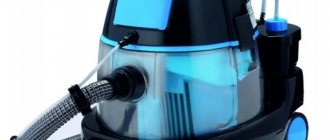TVs with curved screens differ from their analogues in their impressive cost and non-standard appearance. Why do you need such a TV? Are consumers really overpaying solely for original design?
A curved screen also affects the technical characteristics of the device: contrast, viewing angle, image realism, etc. However, how significant is the difference between such TVs and standard models? Let's find out now.
Samsung UE49KU6300
Features of curved screen TVs
Don't forget that curved screens are twice as thick as regular TVs. Such a device will look bad on the wall. To avoid excessive highlighting of the TV along the edges, the equipment must be placed in a pre-created niche.
The comfort zone is another feature that needs a few words about. If the distance from the viewing point to the screen is greater than the diagonal of the TV, then you will not be able to enjoy a high-quality image. The maximum immersion effect will only be if you are in the center and as close to the screen as possible.
Watching TV in a group also becomes noticeably more difficult. Because it is almost impossible to place everyone in the center. Part of the image is lost. The picture becomes too narrow. The distance to the near and far extreme points becomes even more noticeable.
Distortion is another feature common to concave screens. Non-linear distortion occurs when watching a curved TV if you are to the left of your comfort zone. The left side of the picture begins to be in profile.
Xiaomi Mi TV 4S
To objectively evaluate TV equipment, you need to understand the basic technical parameters. Curved and straight screens are significantly different. TVs should be evaluated through the prism of special criteria:
- Brightness. Modern TVs have no problems with this parameter, regardless of the screen type. Users will be able to adjust the brightness of the image;
- Screen resolution. This parameter determines the ratio of the number of pixels per unit area (vertical and horizontal). The higher the resolution, the better the quality of the picture. If the resolution of the video file and the screen match, the image will be perfect;
- Contrast. Indicates the difference in brightness in different areas of the TV screen: from the lightest to the darkest. Contrast can be static or dynamic in different areas of the picture;
- Viewing angle. Defines the maximum permissible angle to the screen plane at which the picture is not distorted. Ideally, this parameter should be 178 degrees;
- Response. Time of change of pixel state. The lower the response, the higher the image clarity. There will be no blur effect;
- Available interfaces. The TV must have everything it needs to sync with other devices;
- Diagonal. Measured in inches. The screen size is determined according to the distance from the viewing point to the screen. The optimal distance is approximately 2-3 diagonals of the TV screen.
Samsung UE40K6500BUX
To determine whether a curved TV is truly superior to a conventional device, compare them using these criteria.
The idea of concave TVs from LG, Samsung, and Sony appeared quite a long time ago. Many companies have used this technology to produce movie screens. A curved screen allows you to solve several important problems:
- Correct transfer of images from the projector to the screen.
- The radius of perception increases for viewers close to the screen.
- Maximum immersion in viewing is ensured, since the person is as if under a dome.
These properties are clearly manifested during viewing in the cinema. However, they are also typical for small curved TVs. Therefore, at home, you can also achieve maximum immersion and optimal radius of perception.
Is it worth buying
To make a final conclusion and decide whether to buy a curved TV, you need to weigh all the advantages and disadvantages of the device, as well as read reviews from customers and experts. Many advantages are offset by negative aspects, and you have to overpay for high display quality.
At the same time, if the user owns a large apartment, likes to watch movies with a lot of dynamic scenes or is fond of games, such a TV will be the best gift for him. Proper placement of the device in the room and the presence of curtains on the windows will prevent reflections and also enhance the effect of immersion in virtual reality.
For a large company or family of 5 or more people, this TV is not suitable. Therefore, buying a curved TV for your home will only be worth it if all viewers feel comfortable looking at the screen and the image is not distorted for each person.
When going to the store to buy a TV, you need to consider the following criteria:
- Screen type. Most models from the budget and mid-price segment are equipped with simple LEDs that provide good display quality. If you have the opportunity to buy a device more expensive than 100 thousand rubles, it is better to give preference to devices with OLED and QLED matrices.
- Screen size. The diagonal of the display is selected taking into account the size of the room where the TV will be installed, and also depends on the distance from which you plan to view video content.
- Permission. The optimal standard for 2021 is 4K.
- Smart TV support. The system makes the TV a full-fledged multimedia center with Internet access and a lot of useful applications.
- Additional functions. When choosing a TV, you should pay attention to the presence of a DVB-T2 tuner and tools for remote control. All connectors and ports must also be present on the device body, including HDMI and USB.
- Price. The cheapest TVs with a curved matrix are sold at a price of 25-35 thousand rubles. The cost of improved models with support for various functions and accessories varies from 45 to 150 thousand rubles.
Advantages and disadvantages of curved TVs
Let's start with aesthetics. Curved models look more modern compared to regular flat TVs. However, there are several pitfalls. Firstly, they are more bulky and voluminous, precisely because of their unusual design. Secondly, they are very difficult to hang on the wall. The process itself is not difficult, but problems will arise with selecting the optimal position.
Samsung UE55NU7500UXUA
By analyzing the pros and cons of a curved screen TV, you can decide whether to purchase such a device. First, let's list the positive qualities:
- glare is reflected well;
- visual perception of the screen increases;
- increased field of view;
- excellent contrast;
- appearance.
The bends of a curved TV also have a negative impact. Main disadvantages:
- When viewing, you need to be in your comfort zone, otherwise the image will be distorted. This is inconvenient for group viewing;
- the overall thickness of the device increases, as a result of which the TV becomes too bulky;
- the effect of curvature appears;
- It is very difficult to fit such a TV into the interior of the room;
- high price.
The cost of maintaining concave TVs is another notable disadvantage. This is explained by the difficulties that arise during the disassembly and subsequent assembly of equipment. Curved TVs are equipped with conventional flat panels. Their deformation is carried out artificially. Therefore, the matrix is constantly in a state of increased tension.
Samsung HU8500
To ensure that the component bends in accordance with the shape of the TV, manufacturers noticeably reduce the thickness of the protective coating. Because of this, the module becomes more fragile. The likelihood of mechanical defects increases.
Avoid marketing gimmicks. Weigh the pros and cons. Having compared the advantages and disadvantages, you will come to the conclusion that, in addition to their beautiful appearance, curved TVs do not have any real technical superiority. For family viewing, this is far from the best solution.
Such models are more suitable for various demonstrations, presentations, and exhibitions. For regular viewing, it is better to buy a flat-screen TV. Direct screens are also not without their drawbacks, but they are intended specifically for home use.
Price/benefit and our final word
As you've probably guessed, we're not fans of curved screens. For the most part, this technology creates more problems than benefits, and several advantages do not cover up the much larger number of objective disadvantages. In addition, such TVs are much more expensive than their flat-panel counterparts. Given the weaknesses of the curvature, we're not sure the price for these TVs is justified.
On the other hand, fans of manufacturers like Samsung, LG and Panasonic have little choice if they want to buy a flagship, since all the best models come with curved screens.
This factor, in part, creates a false impression among potential buyers that the best TVs are those with curved screens. They see that the manufacturer has announced the next flagship, and this flagship has a curved screen, and the consumer begins to think that curvature is cool.
To summarize, I would like to say that the curved screen does not do as much for the TV as we would like, not providing the user with what he expected when buying a curved TV. Yes, it slightly improves the viewing experience, but just a little, and only on large screens. But if you are fascinated by the appearance of such TVs, or just want to be trendy, then go ahead.
17 Sep 2021 S.Denchuk 34150
Share this post
Discussion: there is 1 comment
- Ivan:
10/04/2016 at 10:54Bent TVs certainly look cool, you can’t argue with that!
Answer
Does diagonal size matter?
A very controversial issue. Manufacturers of curved screen TVs claim that size is the determining parameter. It is this characteristic that they justify the high cost of equipment.
QLed Samsung QE 55 Q8C
In theory, a curved screen will provide the maximum level of immersion during the viewing process. The noticeable amount of screen space will be expanded. Add to this the high resolution. Therefore, in theory, a large diagonal curved screen should provide a completely immersive viewing experience and excellent depth.
In practice the situation is different. The newest model with a screen size of 60 inches will not significantly surpass a similar device with a flat display. The actual diagonal of a curved screen is approximately 1 inch larger than a flat screen.
The appearance of additional space helps to increase the field of vision. But this is not a significant difference. Field of view is the degree of viewing while watching TV at a distance of 2.4 meters from the screen. The curved screen will provide an increase in field of view by approximately 1 degree compared to a conventional flat TV.
In fact, immersion and diagonal size do not have a significant impact. You need to calculate the screen size in accordance with the distance from the viewing point to the screen. Therefore, in rooms with a small square footage there is no point in buying devices with a screen diagonal of 60-80 inches. The optimal choice is a distance equal to approximately 2-3 diagonals of the TV screen.
Reflection and viewing angle
A curved TV will reduce contrast on the sides of the screen. Provided that the viewer is located as close as possible to the source of viewing. Modern video file formats will smooth out the contrast on the sides.
Samsung UE49KS7500U
There are very few comfortable viewing points, so watching TV in a large group will be very uncomfortable. However, this drawback is typical for both straight and concave screens. There are no significant differences between these TVs. The declared advantages of curved TV manufacturers are visible only on paper.
Optical distortion is another important point. The sensor sensors of the matrix, which provide focusing, are located throughout the plane. Therefore, video files are initially designed to be viewed on a flat surface. When a curved surface is involved, the picture may become distorted. This criterion once again confirms that ordinary flat TVs are in no way inferior to curved ones.
During viewing, the sun's rays fall on the screen. The curvature of the plane is a catalyst for changing the angle of refraction of rays, so the amount of glare is reduced. This effect is especially noticeable in rooms with bright lighting. The further the user is from the screen, the more the intensity of the glow of foreign objects on the screen will decrease.
Samsung SUHD UE65JS9000TXRU
Less reflections
Curved displays with a glossy finish are much less prone to glare problems than flat displays. With the help of bending, it is possible to change the refraction of light rays and reduce reflections.
Scientists have proven that gloss is capable of reflecting light, even the most minimal, and matte surfaces do not show reflections. Due to the curvature of the matrix, the reflection on curved TVs is stretched and occupies a larger area. At the same time, it loses its brightness and is practically not felt.
However, in order to completely protect yourself from unpleasant glare, it is important to ensure proper placement of the device in the room. The display should not be placed opposite light sources. Still, don't look at the TV in low light.
Some users have complained of bow-tie distortion appearing when running certain types of content. They are accompanied by the top bar stretching along the edges and appear when choosing the wrong viewing position.
Visual increase
A curved TV screen will provide a visual magnification of the image. Even the screen itself will look more voluminous compared to conventional flat displays. However, the effect directly depends on the distance between the screen and the viewing point. The further away the viewer is, the lower the visual perception of screen width. This advantage is also relative.
Visual enlargement is not only an advantage, but at the same time a disadvantage. Due to its design, a curved TV becomes too bulky. Therefore, difficulties arise when placing the device on the wall. It’s easier to put such a TV on a special stand.
Sony KD-50SD8005
Best models
Samsung UE40KU6300U
Gives spectacular sound from the built-in speakers. HDR technology expands brightness coverage. There is a Smart TV function and built-in Wi-Fi for active Internet surfing and searching for movies on the network. The device has a 40-inch diagonal and impeccable color rendition.
LG OLED55C6V
At 55 inches you can fully enjoy 4K quality. The matrix of the device is designed using OLED technology. This means that the pixels are illuminated using organic LEDs. On the TV of this model you can watch 3D video and any common TV broadcast formats. The proprietary Samsung webOS operating system will provide a stable connection to any modern device. Connection between devices can also be done via Wi-Fi or built-in Bluetooth.
Sony KD-55S8505C
The model uses special Motionflow XR 800Hz technology. It smoothes out frame changes, adding liveliness and naturalness. In practice, this is achieved by adding "intermediate frames". The image becomes sharper, and the standard 24-frame film is expanded to 120 frames per second. The operating system of this smart TV is AndroidTV. There is a large library of media files. According to owner reviews, the device often slows down. However, the problem immediately disappears after rebooting the system. One of the positive qualities is that the device has a 55-inch diagonal. One of the negative qualities is weak sound.
Samsung UE55MU6300U
This is the ability to watch 4K video on a 55-inch screen. HDR increases the contrast of the image in dynamics. “Smart” functions are controlled by the Tizen operating system, traditional for Samsung models. The audio system is not very powerful. At the same time, only 20 W gives high-quality and surround sound output. Also, the presence of a light sensor greatly affects the image quality. Thanks to it, the TV itself will adjust the backlight brightness taking into account the time of day around. Therefore, dark scenes are clearly visible even in daylight.
LG OLED65C6V
It does not have a particularly high price compared to other curved models. Despite this, this TV converts 2D to 3D, goes online and connects to many home and mobile devices. Widescreen picture makes it possible to watch content released in 4K quality. In addition, the device can receive both digital and analog signals.
Immersive viewing
Curved TVs provide the most immersive viewing experience. This advantage is determined by the design of the device. This is why cinemas also install screens of this shape. The image looks as natural and realistic as possible. This effect can be achieved due to the fact that the screen bends. The image “comes out” a little forward, literally flowing around the viewer. Although regular TVs are not much inferior to curved models in this regard.
The first reaction of viewers who watched the film on a curved TV was delight. They think they saw a three-dimensional image without 3D glasses. Although in fact this is an ordinary picture in 2D format. This effect occurs because the curved edges increase the visual perception of depth. Samsung enhances this effect by automatically adjusting the contrast of different parts of the picture.
Samsung QE75Q8С
A little history
The first curved TV appeared in 2013. The purpose of creation is to copy the effect that is used in IMAX cinemas. Thanks to the shape of the screen, the contrast and depth of the image increases, which affects the quality of perception and the pleasure of watching movies, especially in 4K format.
Modern TVs with a concave display are immediately equipped with the ability to watch video in 3D, connect Smart TV, perceive 4K resolution and support HDR technology. Manufacturers immediately equip the equipment with all the latest developments. But this also affects the cost of the equipment. A curved screen will cost more than a flat LCD or plasma TV.
Among the main manufacturers of new products are the brands Samsung, LG, Sony, and Philips.











